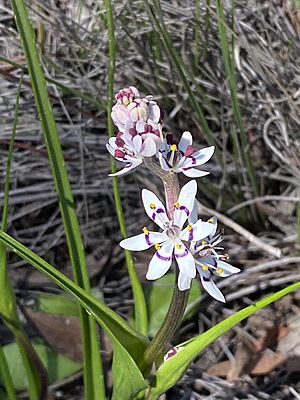Early Nancy facts for kids
Quick facts for kids Early Nancy |
|
|---|---|
 |
|
| Near Goulburn, male flowers above female flowers | |
| Scientific classification | |
| Genus: |
Wurmbea
|
| Species: |
dioica
|
| Synonyms | |
|
|
Wurmbea dioica, commonly known as Early Nancy, is a beautiful small plant that grows only in Australia. It's a type of herb, which means it has soft stems instead of woody ones like trees. This plant usually has three long, thin leaves and pretty white flowers. Each flower often has a purple or green band inside that helps attract insects.
What Does the Early Nancy Look Like?
The Early Nancy is a small herb. It usually grows to be about 3.5 to 40 centimeters (about 1.4 to 16 inches) tall. It has three long, thin leaves that can be from 10 to 350 millimeters (about 0.4 to 14 inches) long. The leaves are also quite narrow, from 0.2 to 6 millimeters (about 0.008 to 0.24 inches) wide.
Interestingly, some Early Nancy plants have only male flowers, some have only female flowers, and some have both. A single plant can have up to fifteen flowers. Each flower has six white tepals, which are like petals. These tepals are about 3.5 to 11.5 millimeters (about 0.14 to 0.45 inches) long.
Inside each tepal, there's a special colored band. This band can be purple, greenish, or white. It's called a nectary band because it helps guide insects to the nectar. The stamens, which are the male parts of the flower, are about half to two-thirds as long as the tepals. The anthers, which hold the pollen, are tiny, about 1 millimeter long, and are usually red or purple.
Early Nancy plants mostly flower from June to November. After flowering, they produce a capsule, which is a dry fruit that opens to release seeds. These capsules are about 5 to 10 millimeters (about 0.2 to 0.4 inches) long.
How Early Nancy Got Its Name
The Early Nancy plant was first officially described in 1810 by a botanist named Robert Brown. He gave it the name Anguillaria dioica. Later, in 1877, another botanist named Ferdinand von Mueller changed its name to Wurmbea dioica. This is the name we use today.
Scientists have also found three different types, or subspecies, of Early Nancy. These subspecies are slightly different from each other:
- Wurmbea dioica subsp. alba: This type has flowers that are completely white.
- Wurmbea dioica subsp. brevifolia: This one has a shorter, egg-shaped top leaf and tepals with pink edges.
- Wurmbea dioica subsp. dioica: This is the most common type. It has a longer top leaf with a thin, tapering tip and a purple nectary band.
Where Does Early Nancy Grow?
The Early Nancy plant is very common and can be found all over Australia. It grows in all six Australian states and the Australian Capital Territory. However, it is not found in the Northern Territory. You can find this plant in many different kinds of places, or habitats.
The most common type, subsp. dioica, grows in all the eastern states, South Australia, and the Australian Capital Territory. The subsp. brevifolia is found in Victoria and South Australia. It prefers drier areas than subsp. dioica. The subsp. alba is only found in Western Australia. It likes to grow in swamps that are wet in winter and around granite rocks.

